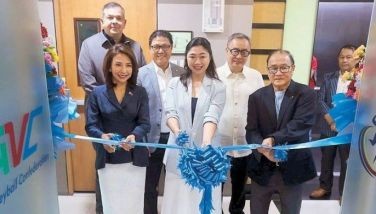Sound environment practices = corporate savings and efficiencies
April 28, 2003 | 12:00am
Flexible packaging company Cygnus Industries, has installed a wastewater treatment facility for less than a fifth of the cost of a P500,000 conventional plant. Fortune Packaging Corp. has put up a wastewater treatment facility for only P42,000.
Cygnus and Fortune are both participants of Nestlé Phils.’ "Greening the Supply Chain", an initiative launched in August 2000 to promote environmentally friendly practices among its business partners by helping them formulate and implement their own environmental management systems.
GSC is the first of its kind in the Nestlé world. It has also been included in an anthology of 68 cases on sustainable development entitled "Walk the Talk", launched by the World Business Council for Sustainable Development at the World Summit on Sustainable Development in Johannesburg in September 2002.
The company’s commitment to protect the environment is globally enforced through the Nestlé Environmental Management System, a comprehensive framework that governs the environmental practice of the firm’s operations worldwide, including the Philippines, which is the company’s 11th biggest subsidiary.
The NEMS mandates the constant monitoring of the environmental impact of company activities and continuing efforts to ensure environmentally sound business practices. The NEMS also requires the company to assess the environmental impact of the operations of its business partners, who supply materials and provide services.
"We expect the same level of commitment to environmental protection from our business partners. We expect them to support, if not initiate, efforts to help protect the environment and, more importantly, to have the attitude which says this is a worthy thing to do," said Nestlé Phils. chairman Juan Santos.
In the case of GSC, Nestlé identified the first batch of business partners or 28 out of the total 300 in the list. The chief executive officers of these companies were then invited to a meeting where the GSC was explained.
"Commitment to protecting the environment must always start from the top," said Santos. "The starting point towards a sustainable program for the environment is having the proper mindset for it, ably supported by a management commitment to ensure that this mindset is shared by everyone in the organization through employee involvement. It is not how much we spend nor the resources we commit that is the key to success or any environmental initiative. Rather, it is our attitude to do what is necessary. Helping protect the environment is no longer an option, it has become a necessity."
After the CEOs’ meeting, Nestlé held a two-day training on the basics of EMS for the participating partners. Nestlé environmental officers visited the work sites of its business partners to assess their operations and to determine how their environmental performance could be improved. These efforts were then reinforced with follow-up day-long sessions held every three to four months to discuss lessons learned. Participants with early successes shared their experiences and best practices They also visited Nestlé’s five factories to learn environmental practices and to implement those applicable to them.
Then, Nestlé environmental officers conducted another round of visits to monitor and guide the EMS implementation of partners. Once results were achieved, the partners reported their milestones, and these were validated by Nestlé.
A second batch of GSC participants, numbering 48, are currently setting up their respective EMS
A member of the first batch is Central Azucarera de Don Pedro, which mills refined sugar in Nasugbu, Batangas. Because of its involvement in GSC, the sugar central has established a waster materials recovery facility that produces organic fertilizer or soil conditioner in partnership with technology provider, Lacto-Asia Pacific, and the Luntiang Nasugbu Multi-Purpose Cooperative.
"We used to take the mud press from sugar manufacturing to a landfill to decompose naturally. The mud press generated an odor, plus heat while decomposing, that caused spontaneous combustion. The smoke would bother the residents nearby. There was also leaching of sugar and other organic substances into the groundwater," said CDP’s Jeffrey Mijares, who is concurrent president of the Pollution Control Association of the Philippines.
Operational since December 2002, the facility has cut the decomposition rate of the mud press from 60 days into half. Technological inputs from Lacto-Asia include the design of the rotary composters with a capacity of 1.3 tons each, providing the composting inoculant to accelerate decomposition and other technical services.
The P6.5 million total cost of the facility is shouldered by CDP.
"The facility is currently producing six tons of organic fertilizer a day. We plan to sell it at P per kilo under the brand, Sweet Earth, as soon as we have complied with government requirements. Elsewhere, organic fertilizer is sold starting at P5 per kilo. Our initial anaylsis shows that our product exceeds the Fertilizer and Pesticides Authority requirement of 7% for NPK content. Ours is 9% to 12% NPK. We think it’s a very superior natural fertilizer," said Mijares.
Aside from directly employing eight people, the downstream-upstream benefits of the facility include a good way to dispose of manure for poultry raisers, new business for bag manufacturers for the fertilizer, opportunities for transport providers, and income for producers of coco dust, the principal component of the fertilizer inoculant.
One of the highlights of Cygnus’s EMS efforts is a monitoring system with software designed to track the use of electric power by various machines.
"The system detects fluctuations and immediately corrects problems involving electricity, resulting in savings of up to 3% in power consumption," said Cygnus environmental auditor Raquel Zapata.
In Fortune’s case, a system has been installed that monitors water use, identifying areas where usage is high as well as leaks. A power monitoring system has also been put in place that enables lights and machines to be turned off when not in use.
The company now segregates solid wastes from the offset process, including paper, rags, bottles, metals and plastics. Rather than washing paint from the rollers with water, rags are now used and recycled, resulting in further savings.
"The best benefits of GSC are the updating of information on environmental laws and regulations, the sharing of technologies among partners, and the dissemination of environment best practices applicable to us," said Fortune’s Noy Sun.
"GSC is for the long term," said Nestlé environmental officer Jesus Reyes. "It takes time for environmental initiatives to see fruition, and this why we have been careful in implementing GSC– to make sure that the expected benefits are realized in a sustainable manner, for the long-term. We prefer to take things step by step with milestones achieved as we complete a step, and with each step building on the next. A modest approach perhaps but sustainable with long-lasting impact towards environmental protection.
The GSC program has proven that small businesses can be at par with bigger firms in caring for the environment and both can benefit from each other’s sound environment practices in terms of savings and efficiencies.
Cygnus and Fortune are both participants of Nestlé Phils.’ "Greening the Supply Chain", an initiative launched in August 2000 to promote environmentally friendly practices among its business partners by helping them formulate and implement their own environmental management systems.
GSC is the first of its kind in the Nestlé world. It has also been included in an anthology of 68 cases on sustainable development entitled "Walk the Talk", launched by the World Business Council for Sustainable Development at the World Summit on Sustainable Development in Johannesburg in September 2002.
The NEMS mandates the constant monitoring of the environmental impact of company activities and continuing efforts to ensure environmentally sound business practices. The NEMS also requires the company to assess the environmental impact of the operations of its business partners, who supply materials and provide services.
"We expect the same level of commitment to environmental protection from our business partners. We expect them to support, if not initiate, efforts to help protect the environment and, more importantly, to have the attitude which says this is a worthy thing to do," said Nestlé Phils. chairman Juan Santos.
"Commitment to protecting the environment must always start from the top," said Santos. "The starting point towards a sustainable program for the environment is having the proper mindset for it, ably supported by a management commitment to ensure that this mindset is shared by everyone in the organization through employee involvement. It is not how much we spend nor the resources we commit that is the key to success or any environmental initiative. Rather, it is our attitude to do what is necessary. Helping protect the environment is no longer an option, it has become a necessity."
After the CEOs’ meeting, Nestlé held a two-day training on the basics of EMS for the participating partners. Nestlé environmental officers visited the work sites of its business partners to assess their operations and to determine how their environmental performance could be improved. These efforts were then reinforced with follow-up day-long sessions held every three to four months to discuss lessons learned. Participants with early successes shared their experiences and best practices They also visited Nestlé’s five factories to learn environmental practices and to implement those applicable to them.
Then, Nestlé environmental officers conducted another round of visits to monitor and guide the EMS implementation of partners. Once results were achieved, the partners reported their milestones, and these were validated by Nestlé.
A second batch of GSC participants, numbering 48, are currently setting up their respective EMS
"We used to take the mud press from sugar manufacturing to a landfill to decompose naturally. The mud press generated an odor, plus heat while decomposing, that caused spontaneous combustion. The smoke would bother the residents nearby. There was also leaching of sugar and other organic substances into the groundwater," said CDP’s Jeffrey Mijares, who is concurrent president of the Pollution Control Association of the Philippines.
Operational since December 2002, the facility has cut the decomposition rate of the mud press from 60 days into half. Technological inputs from Lacto-Asia include the design of the rotary composters with a capacity of 1.3 tons each, providing the composting inoculant to accelerate decomposition and other technical services.
The P6.5 million total cost of the facility is shouldered by CDP.
"The facility is currently producing six tons of organic fertilizer a day. We plan to sell it at P per kilo under the brand, Sweet Earth, as soon as we have complied with government requirements. Elsewhere, organic fertilizer is sold starting at P5 per kilo. Our initial anaylsis shows that our product exceeds the Fertilizer and Pesticides Authority requirement of 7% for NPK content. Ours is 9% to 12% NPK. We think it’s a very superior natural fertilizer," said Mijares.
Aside from directly employing eight people, the downstream-upstream benefits of the facility include a good way to dispose of manure for poultry raisers, new business for bag manufacturers for the fertilizer, opportunities for transport providers, and income for producers of coco dust, the principal component of the fertilizer inoculant.
"The system detects fluctuations and immediately corrects problems involving electricity, resulting in savings of up to 3% in power consumption," said Cygnus environmental auditor Raquel Zapata.
In Fortune’s case, a system has been installed that monitors water use, identifying areas where usage is high as well as leaks. A power monitoring system has also been put in place that enables lights and machines to be turned off when not in use.
The company now segregates solid wastes from the offset process, including paper, rags, bottles, metals and plastics. Rather than washing paint from the rollers with water, rags are now used and recycled, resulting in further savings.
"The best benefits of GSC are the updating of information on environmental laws and regulations, the sharing of technologies among partners, and the dissemination of environment best practices applicable to us," said Fortune’s Noy Sun.
The GSC program has proven that small businesses can be at par with bigger firms in caring for the environment and both can benefit from each other’s sound environment practices in terms of savings and efficiencies.
BrandSpace Articles
<
>
- Latest
Latest
Latest
December 17, 2024 - 12:00am
December 17, 2024 - 12:00am
December 16, 2024 - 10:00am
December 16, 2024 - 10:00am
December 5, 2024 - 12:00am
December 5, 2024 - 12:00am
November 29, 2024 - 9:30am
November 29, 2024 - 9:30am
November 28, 2024 - 8:00am
November 28, 2024 - 8:00am
Recommended






























